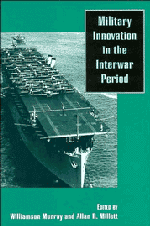Book contents
- Frontmatter
- Contents
- Acknowledgments
- Introduction
- 1 Armored warfare: The British, French, and German experiences
- 2 Assault from the sea: The development of amphibious warfare between the wars – the American, British, and Japanese experiences
- 3 Strategic bombing: The British, American, and German experiences
- 4 Close air support: The German, British, and American experiences, 1918–1941
- 5 Adopting the aircraft carrier: The British, American, and Japanese case studies
- 6 Innovation ignored: The submarine problem – Germany, Britain, and the United States, 1919–1939
- 7 From radio to radar: Interwar military adaptation to technological change in Germany, the United Kingdom, and the United States
- 8 Innovation: Past and future
- 9 Patterns of military innovation in the interwar period
- 10 Military innovation in peacetime
- Index
7 - From radio to radar: Interwar military adaptation to technological change in Germany, the United Kingdom, and the United States
Published online by Cambridge University Press: 05 August 2012
- Frontmatter
- Contents
- Acknowledgments
- Introduction
- 1 Armored warfare: The British, French, and German experiences
- 2 Assault from the sea: The development of amphibious warfare between the wars – the American, British, and Japanese experiences
- 3 Strategic bombing: The British, American, and German experiences
- 4 Close air support: The German, British, and American experiences, 1918–1941
- 5 Adopting the aircraft carrier: The British, American, and Japanese case studies
- 6 Innovation ignored: The submarine problem – Germany, Britain, and the United States, 1919–1939
- 7 From radio to radar: Interwar military adaptation to technological change in Germany, the United Kingdom, and the United States
- 8 Innovation: Past and future
- 9 Patterns of military innovation in the interwar period
- 10 Military innovation in peacetime
- Index
Summary
BACKGROUND AND TERMINOLOGY
Given the way that electronic warfare characterizes today's battlefields, it is sometimes difficult to remember that scientists discovered the very existence of radio waves barely a century ago. Yet already by 1904 a young German named Christian Hülsmeyer claimed his patented “telemobiloscope” could transmit radio waves and receive their reflections off a passing object. He suggested that such a device could prevent collisions at sea or aid navigation. Representatives of shipping lines flocked to various demonstrations in Germany and Holland and were impressed that the device could detect objects up to a range of approximately five kilometers. But there were no buyers. At the time investment capital was scarce in the maritime industry, wireless telegraphy already offered a means of communication among ship's captains (as well as a form of direction-finding by means of cross-bearings from shore stations), and the legal and technical relationships between this use of radio waves and the patented wireless telegraphy of the Marconi monopoly were unclear to shipowners. That is, budgets were tight, other devices that seemed to fulfill present needs already existed, and it took real imagination to sort out the nature and possibilities of something so new. The first two factors are nearly constants, for resources throughout history are usually limited and few human needs are totally unmet. The key to the timing that turns a discovery or invention into successful innovation lies in whether laymen can envision its possibilities.
- Type
- Chapter
- Information
- Military Innovation in the Interwar Period , pp. 265 - 299Publisher: Cambridge University PressPrint publication year: 1996
- 4
- Cited by

